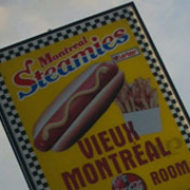Last night, I attended a “Q&A and discussion of mixes by attendees” featuring Larry Crane at Hotel2Tango Studios. I first learned about Larry through his magazine Tape Op, who is now the world’s second- or third-largest circulation recording magazine. I discovered it in the 1990s at Quimby’s bookstore in Chicago, when I was there to do a reading for Bad Subjects. At the time, it was a classic ‘zine–handmade and photocopied. I don’t remember what issue was on sale that day but read it and was inspired. I sent for all the back issues, and have been a dedicated reader since (and have reviewed it for Bad Subjects here and here). The progress of the magazine also mirrors Larry’s career progress, as he’s amassed some serious engineering and production credits with acts like Sleater-Kinney, Quasi and Elliott Smith.
Larry is an organic intellectual of the recording world (though if I’m not mistaken, he does actually have some kind of Communication Studies degree). The event lasted about six hours (I bailed at 11:30), beginning with Howard Bilerman (a very interesting character in his own right, whom I hadn’t met before last night) interviewing Larry about his career and quickly getting into the making of various recordings. Larry played us some of his work and discussed a wide range of issues, from mic selection to playing with a noise gate, to dealing with band politics, to a feminist reminder to the male engineers not to be “the asshole with the equipment” when recording women. The last third or so of the evening was critiquing recordings brought by the attendees, some of which were amazing (including the Juno-winning Chic Gamine). Although the recordings were all different genres and approaches, it was fascinating to hear work from a bunch of aspiring engineers at different levels and to see what kinds of suggestions were being made. #1 suggestion, which I already knew but was totally reinforced, is that the majority of mixing problems are arrangement problems, and the next biggest category is problems in the original recordings. Get those two things right, and there is a lot of latitude to play. With a bit of the novice’s nervousness, I brought a still-unfinished lo-boy mix where I was hoping for more rock edge and dynamics and have been winding up with more flat. I’m used to running workshops like this (how to think about your academic career, how to apply for a research grant, etc) so it was fun to be back on the other side as a student and have my work critiqued. It was totally valuable too. I thought the flatness came from too much production–both Larry and Howard said there wasn’t enough. Outstanding. What engineer doesn’t want to hear “why don’t you try some more processing on that?” and then get a bunch of suggestions for things to try with echoes and reamping? Wait, don’t answer that.
I also took the liberty of checking out Hotel2Tango, which is a beautiful studio and a very comfortable space. It’s one of those things–I’ve lived here for just under 5 years now and there are still all these vital parts of the local culture, like the studio scene, that I just haven’t explored at all. I’m sure there’s some comment on globalization in here, where it takes a visit from someone out of town to give me a reason to explore something in town, but I guess that’s how it works.
Every time I do something with music–which is not nearly often enough–I am reminded of how much I need to get more music back into my life.
